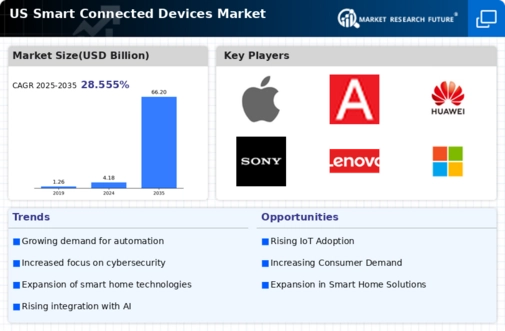The US Smart Connected Devices Market has witnessed significant growth and innovation, fueled by advancements in technology and an increasing consumer appetite for connectivity and smart features. This market encompasses a wide range of devices, including smartphones, tablets, smart speakers, wearables, and Internet of Things (IoT) devices that enhance daily life through seamless integration with personal and home systems. With rising competition among major players, companies are investing heavily in research and development to provide cutting-edge features and improve user experience.
The dynamic nature of consumer preferences and the push for sustainability are further shaping strategies, leading to collaborations, mergers, and acquisitions as firms strive to capture more market share and develop comprehensive ecosystems that meet the demands of modern consumers. As a result, understanding the competitive landscape is crucial for identifying trends and formulating effective strategies that cater to a diverse and evolving customer base.
Apple holds a prominent position in the US Smart Connected Devices Market, leveraging its strong brand loyalty, innovative technology, and diverse product ecosystem. The company's focus on user experience, premium design, and seamless integration across its devices, such as the iPhone, iPad, Mac, and Apple Watch, strengthens its market presence and consumer engagement. Apple's robust operating system, iOS, enhances compatibility and ensures a user-friendly environment that keeps customers within its ecosystem. With a strong emphasis on privacy and security, Apple differentiates itself from competitors, appealing to a consumer base that values data protection.
The company also invests in continuous research and development to introduce cutting-edge features and services, further solidifying its leadership in the market. Its strategic marketing initiatives and strong retail presence contribute to its competitive advantage, allowing Apple to maintain a loyal customer base and grow its market share within the US.
Alphabet operates strategically within the US Smart Connected Devices Market, primarily through its flagship product, Google Nest, which includes smart home devices such as speakers, displays, and thermostats, as well as its Android operating system powering many smartphones and tablets. This diversification into IoT and smart home technology complements the Google ecosystem, allowing seamless integration with applications like Google Assistant and Google Home. Alphabet's strengths lie in its significant investments in artificial intelligence and machine learning, enabling smart connected devices to offer personalized user experiences and smart automation.
The company has also expanded its market presence through mergers and acquisitions, such as its investment in various smart device manufacturers, enhancing its portfolio and competitive edge. With a strong focus on innovation and consumer-centric design, Alphabet is well-positioned to capitalize on emerging trends in the US, further solidifying its role as a key player in the smart connected devices sector.




















Leave a Comment